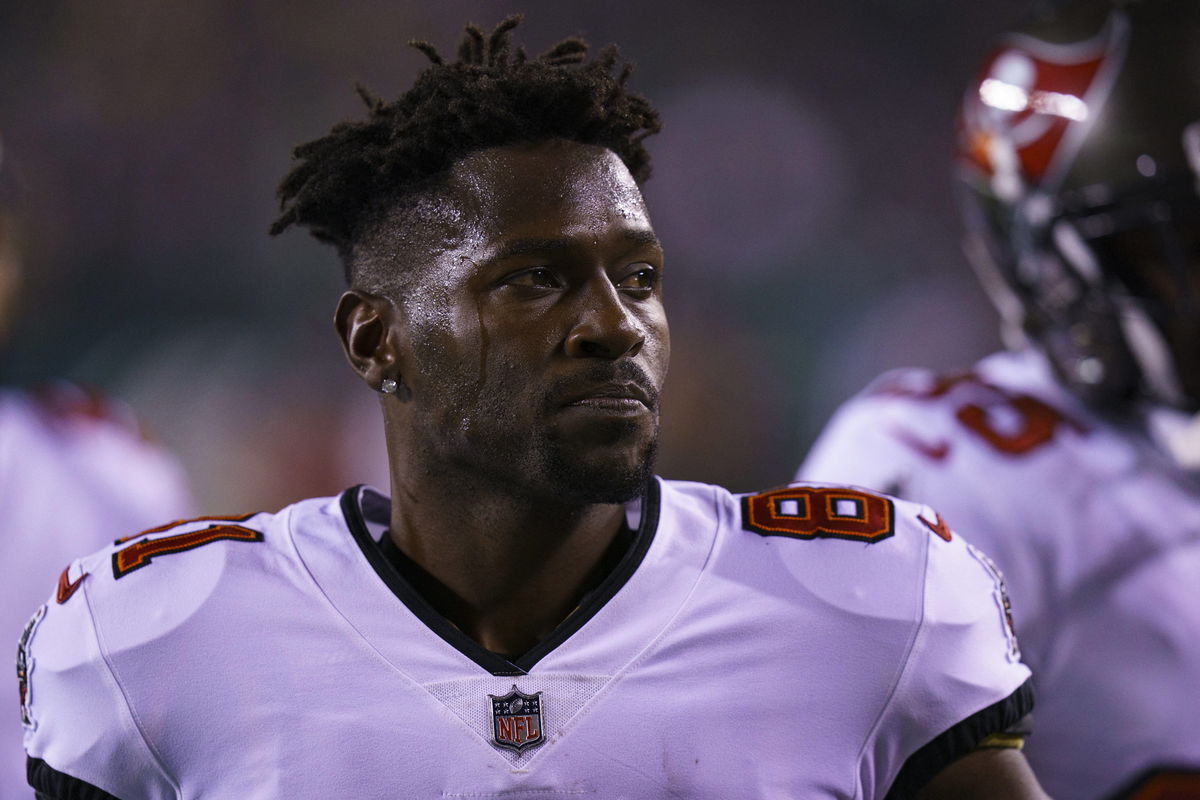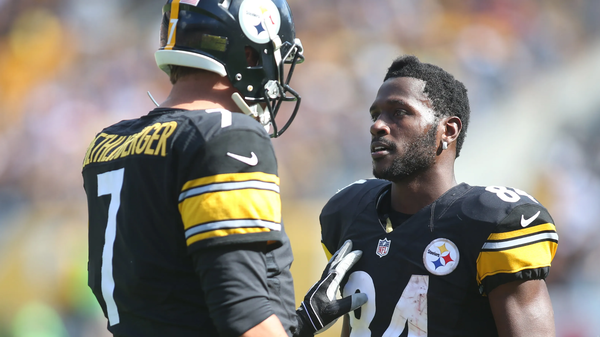
Imago
NFL, American Football Herren, USA 2021: Buccaneers vs Eagles Oct 14 October 14, 2021: Tampa Bay Buccaneers wide receiver Antonio Brown 81 looks on prior to the NFL game between the Tampa Bay Buccaneers and the Philadelphia Eagles at Lincoln Financial Field in Philadelphia, Pennsylvania. Christopher Szagola/CSM Philadelphia Pennsylvania USA EDITORIAL USE ONLY Copyright: xx ZUMA-20211014_zaf_cs7_082.jpg ChrisxSzagolax csmphototwo808938

Imago
NFL, American Football Herren, USA 2021: Buccaneers vs Eagles Oct 14 October 14, 2021: Tampa Bay Buccaneers wide receiver Antonio Brown 81 looks on prior to the NFL game between the Tampa Bay Buccaneers and the Philadelphia Eagles at Lincoln Financial Field in Philadelphia, Pennsylvania. Christopher Szagola/CSM Philadelphia Pennsylvania USA EDITORIAL USE ONLY Copyright: xx ZUMA-20211014_zaf_cs7_082.jpg ChrisxSzagolax csmphototwo808938
The world of sports is no stranger to dramatic falls from grace. Think of it like a ninth-inning collapse in Game 7—a mix of chaos, disbelief, and inevitability. Antonio Brown’s career has been a highlight reel of such moments, blending gridiron brilliance with off-field turbulence. But even for a player whose antics once felt as routine as a halftime show, his latest chapter feels more like a horror flick than a sports documentary.
Watch What’s Trending Now!
Imagine a scene ripped from a Miami Vice episode: flashing lights, panicked crowds, and the crackle of tension. Now swap pastel suits for gold chains and sports cars. This isn’t fiction. On May 16, 2025, Antonio Brown’s alleged arrest at influencer Adin Ross’s boxing event sent shockwaves through social media. The reason? Allegedly firing a g-n during a brawl over a stolen chain. But the real twist came later—on camera.
Escorted by police, Brown returned to Ross’s livestream, where he dropped a bombshell: “I have CTE. I don’t know what happened! I blacked out, dude.” The confession, raw and unfiltered, echoed like a stadium siren. CTE—chronic traumatic encephalopathy—has haunted the NFL for decades, tied to repeated head trauma. Brown’s admission, whether a plea or a deflection, reframed the incident instantly.
ADVERTISEMENT
The altercation itself was messy. Videos showed Brown tussling with a crowd, g-nshots ringing out, and chaos erupting. Ross later claimed, “You can’t take down AB,” as if applauding a touchdown. But eyewitnesses described a darker scene. Streamer FaZe Lacy admitted, “I grew up in the suburbs… I’m not used to this s—,” his voice trembling post-incident. But this wasn’t Brown’s first rodeo.
Antonio Brown tells Adin Ross. “I have CTE I don’t know what happened!” After allegedly firing a gun after a robbery attempt of his chain and being released by police. pic.twitter.com/4KtdsxsuUa
— VideoMixtape.com (@VideoMixtape_) May 17, 2025
From his infamous mid-game strip-off during a 2021 Buccaneers–Jets game to legal battles ranging from burglary and battery charges in 2020 to s–ual misconduct allegations, Brown’s post-NFL spiral has been unrelenting. In 2022, he was issued an arrest warrant for unpaid child support. Later in the year, there were multiple reports that he staged a bizarre standoff with law enforcement at his Tampa home after accusations of domestic battery. He recently caught attention with inflammatory comments on the Sanders family and even former teammate Tom Brady, with whom he won a Super Bowl. The 2015 playoff hit by Vontaze Burfict—a helmet-to-helmet collision that left him concussed—now feels like a grim footnote.
ADVERTISEMENT
The CTE conundrum
CTE, often diagnosed only posthumously, is linked to aggression, depression, and cognitive decline. The condition has loomed over the legacies of several former NFL stars. Hall of Fame linebacker Junior Seau was diagnosed with CTE after his 2012 suicide. Former Patriots tight end Aaron Hernandez was posthumously found to have advanced CTE at age 27. Even Demaryius Thomas, who died suddenly in 2021, was reported to have had stage 2 CTE. The disease’s toll on athletes, particularly football players, has become one of the league’s most contentious storylines.
ADVERTISEMENT
Brown’s public acknowledgment adds urgency to football’s safety debate. Yet questions linger. Was the arrest a result of self-defense or recklessness? Police released him without charges, citing an ongoing investigation. Social media footage showed Brown sprinting with what seemed like a firearm, but context was scarce. Ross’s camp insists it was a robbery attempt; critics call it another attention stunt.

ADVERTISEMENT
His former teammate, Ben Roethlisberger, once called him “the hardest worker I’ve ever seen.” Now, Brown’s legacy is a Rorschach test. The May 16 incident blends violence and vulnerability. And it complicates the narrative further. Meanwhile, the conversation splits. Some sympathize: a troubled man grappling with an invisible disease. Others see a pattern of defiance. Adin Ross’s glib endorsement—“right calls were made”—clashes with FaZe Lacy’s trauma.
But Brown’s arrest isn’t just a tabloid headline. It’s a mirror held up to sports culture. Where fame collides with frailty, and heroism fades faster than a halftime lead. As F. Scott Fitzgerald wrote, “Show me a hero, and I’ll write you a tragedy.” For Antonio Brown, the final chapter remains a mystery. But how many warnings does a society need before the story changes?
ADVERTISEMENT
Will his confession spark empathy or skepticism? The answer, much like CTE itself, hides in the shadows.
ADVERTISEMENT
ADVERTISEMENT
ADVERTISEMENT

